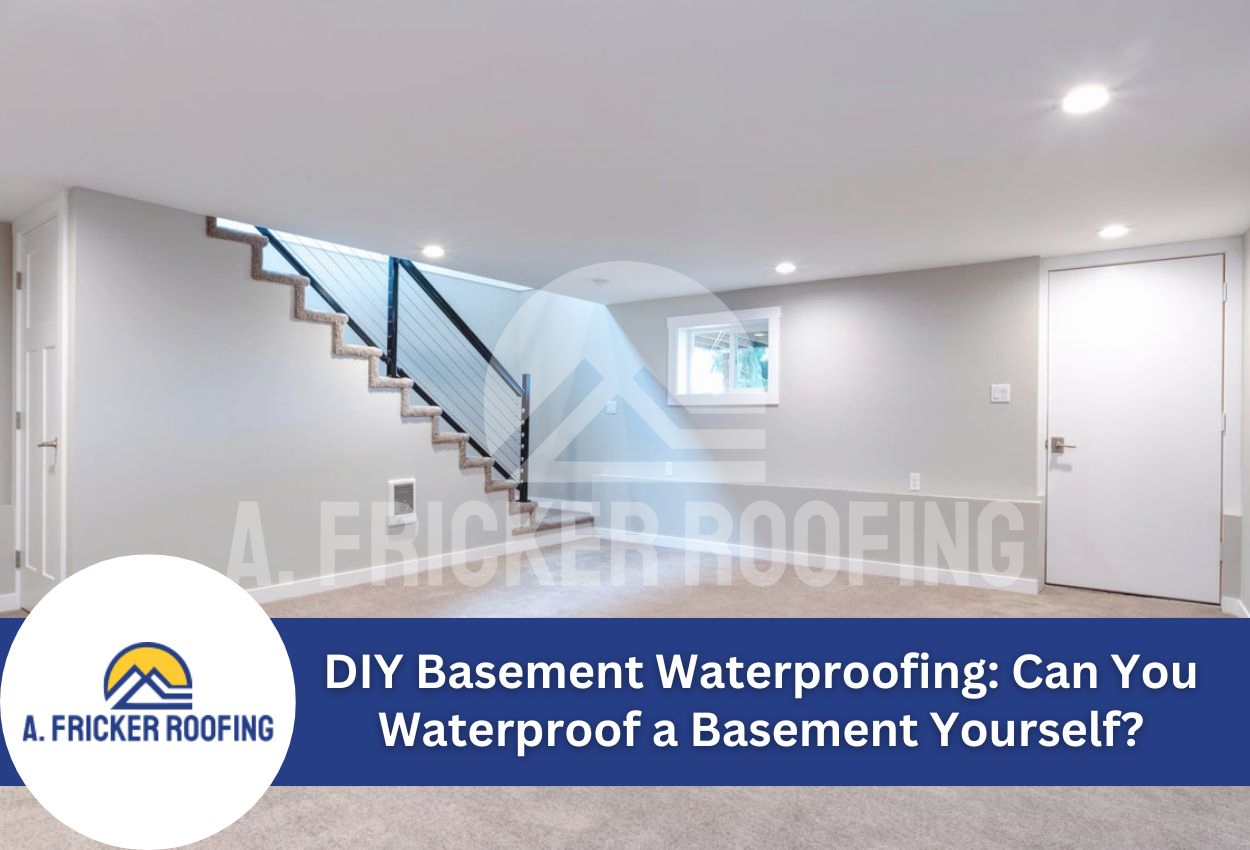Dealing with a wet basement can be frustrating for Tulsa homeowners. When moisture seeps through foundation walls or floors, it creates an environment for mold growth, damaged belongings, and decreased property value. Many homeowners wonder if basement waterproofing is something they can tackle themselves or if professional help is necessary.
The good news is that several effective DIY basement waterproofing methods exist for minor to moderate water issues. Homeowners who complete their own waterproofing projects typically experience significant savings compared to hiring professionals, while also gaining valuable home maintenance skills that prove useful for future projects.
However, not all basement moisture problems are suitable for DIY solutions. Understanding the source and severity of water is important before deciding whether to proceed on your own. Interior basement waterproofing solutions, like applying waterproof paint, installing proper drainage, and sealing cracks, can be manageable for most homeowners with basic tools and skills. More severe issues involving structural damage or significant water pressure against foundation walls may require professional expertise.
This guide explores practical basement moisture prevention techniques and helps you determine if your specific situation is appropriate for a DIY approach or if it requires professional waterproofing services.
Assessing Your Basement’s Moisture Issues
Before tackling any DIY basement waterproofing project in your Tulsa home, you need to properly identify the source and severity of your moisture problems. Oklahoma’s clay-heavy soils and seasonal rainfall patterns create unique challenges for basement waterproofing, making proper assessment important to success.
Start by looking for signs of leaks: white powdery residue (efflorescence) on walls, peeling paint, visible water stains, or mold growth. Pay attention to when moisture appears. If it shows up after heavy rain, this could mean it is coming in through foundation cracks, while consistent dampness regardless of weather often points to condensation issues. Oklahoma homes frequently experience hydrostatic pressure problems where groundwater pushes against foundation walls.
Simple testing tools can help determine the moisture level in your basement. A moisture meter (ranging from about $40 to as expensive as $200 at hardware stores) provides readings of moisture content in walls and floors. Another way to check is to place aluminum foil squares on suspect walls overnight. Condensation on the wall-facing side indicates seepage, while room-side moisture suggests humidity issues.
Document all of your findings, including photographs and moisture readings (if possible). This assessment helps determine whether DIY interior basement waterproofing solutions will suffice or if your situation requires professional intervention for preventing basement leaks and flooding.
Essential Supplies and Tools for DIY Basement Waterproofing
Successful DIY basement waterproofing requires having the right materials and tools on hand before you begin. For basic moisture barrier installation, you’ll need hydraulic cement, concrete patching compound, masonry waterproofing paint, caulk, and plastic sheeting. More advanced interior drainage solutions require PVC pipes, gravel, a drainage membrane, and a sump pump system. Don’t forget essential safety equipment like rubber gloves, eye protection, and respirators to protect yourself from dust and chemical exposure.
Tool requirements vary based on your chosen waterproofing method. You’ll likely need a hammer drill with masonry bits for creating drainage holes, a shovel for excavation work, a wet/dry vacuum for cleanup, and various trowels for applying patching compounds. For sealing basement walls against water, you’ll also want quality brushes and rollers to apply waterproof paint.
Tulsa homeowners can find most supplies at local hardware stores. For specialized waterproofing products, check out local construction supply stores. If budget is a concern, consider renting expensive tools like hammer drills from equipment rental services throughout Tulsa rather than purchasing them outright. Many basement moisture prevention techniques can be accomplished using affordable alternatives to specialized tools, making DIY waterproofing accessible to most homeowners.
Interior Waterproofing Solutions You Can Implement Yourself
When dealing with basement moisture issues in your home, several DIY waterproofing methods can be effective without calling in professionals, but the clay soil common throughout Tulsa and the surrounding areas creates challenges that require specific approaches to interior waterproofing.
For wall and floor protection, begin by thoroughly cleaning surfaces with a wire brush to remove efflorescence and loose material. Apply a quality waterproof coating specifically designed for basements. Look for products containing Portland cement that bond chemically with concrete. For Oklahoma’s clay soil, choose products rated for high hydrostatic pressure resistance. Apply the coating with a thick-nap roller, working the material into pores and crevices, then allow for a proper amount of time for curing before exposing it to moisture.
Installing interior drainage solutions can redirect water that penetrates your foundation. A DIY French drain system involves creating a trench along basement walls, laying perforated pipe surrounded by gravel, and connecting it to a sump pump. While this requires significant effort, most homeowners can complete it over a weekend using materials from local hardware stores. The sump pump installation requires creating a basin in the lowest part of your basement where water collects, then connecting the pump to an exterior discharge pipe.
Exterior Approaches to Prevent Water Infiltration
The most effective basement waterproofing strategy begins outside your home, where you can stop water before it reaches your foundation. In Tulsa’s climate, with its heavy seasonal rains and expansive clay soils, proper exterior measures are particularly important for long-term basement protection.
Improving yard drainage starts with examining how water flows around your property during rainfall. The ground should slope away from your foundation at a rate of at least 6 inches over the first 10 feet. You can create this grade yourself using clean fill dirt (not topsoil, which absorbs water). Once properly sloped, cover with a layer of topsoil and grass to prevent erosion. For stubborn drainage issues, consider installing a French drain system in your yard to collect and redirect surface water away from your foundation.
Foundation walls themselves can be waterproofed using specialized exterior sealants. After thoroughly cleaning the exposed foundation, apply a waterproofing membrane or coating designed specifically for Oklahoma’s soil conditions. Many homeowners also install a dimpled drainage mat against foundation walls that creates a small air gap, allowing water to drain down to the foundation footing instead of pressing against the wall. This works particularly well in Tulsa’s clay soil that tends to retain moisture for extended periods.
Long-Term Maintenance to Keep Your Basement Dry
After implementing DIY waterproofing solutions in your Tulsa basement, consistent maintenance becomes important for lasting protection. Oklahoma’s weather shifts, from heavy spring rains to summer drought and winter freezes, can stress even well-executed waterproofing systems over time.
Create a seasonal maintenance schedule to protect your investment. Before spring rains, clean gutters and downspouts, test sump pumps, and inspect exterior drainage paths for blockages. After heavy rainfall, check for new water intrusion points and promptly address any seepage. In the fall, ensure gutters are leaf-free and extend downspouts further from the foundation. Before winter, inspect and seal any foundation cracks, as Oklahoma’s freeze-thaw cycles can expand existing openings.
Monitor your waterproofing system’s effectiveness by regularly checking for warning signs. Use a moisture meter on previously damp areas to detect changes before visible problems appear. Watch for new efflorescence, musty odors, or increased humidity levels. Keep a simple log tracking any leaks and any weather that happens when they do. Small issues like minor leaks after unusually heavy rain might only require minimal intervention, while persistent dampness despite dry weather indicates your DIY waterproofing needs enhancement.
When to Call the Professionals
While DIY basement waterproofing can address many common moisture issues, some situations call for professional expertise. Recognizing these scenarios can save Tulsa homeowners time, money, and frustration in the long run. The unique soil composition and weather patterns in northeastern Oklahoma create specific challenges that sometimes exceed typical DIY solutions.
Look for warning signs that indicate professional help is needed: horizontal cracks in foundation walls, bowing or leaning, floor cracks wider than 1/8 inch, or standing water that remains after heavy rainfall. These symptoms often point to structural issues or severe hydrostatic pressure problems. Neighborhoods in low-lying areas near creek or river tributaries frequently experience these more serious water issues that DIY methods simply cannot adequately address.
When selecting a waterproofing contractor in the Tulsa area, start by requesting recommendations from neighbors who have successfully resolved similar issues. Verify that potential contractors hold proper Oklahoma licensing and insurance, and ask about their specific experience with the clay-rich soil in our region. Request detailed written estimates from at least three companies, and ask each to explain their proposed solution’s long-term effectiveness. Many reputable contractors can work alongside your DIY efforts, addressing structural concerns while you handle simpler interior waterproofing tasks.
Expert Help for Complex Waterproofing in Tulsa With A. Fricker Roofing and Waterproofing
If your DIY basement waterproofing project in Tulsa reveals issues that are beyond simple fixes, like severe flooding or structural concerns, it’s important to call in the experts. A. Fricker Roofing and Waterproofing specializes in addressing water and foundation issues that can threaten your home’s structural integrity and safety. Secure your property’s value and your peace of mind by reaching out for professional help.
For immediate assistance and evaluation of your basement’s needs, call A. Fricker Roofing and Waterproofing now at (918) 402-7167. Our team is ready to provide the expertise and solutions necessary to keep your home dry and protected year-round.

